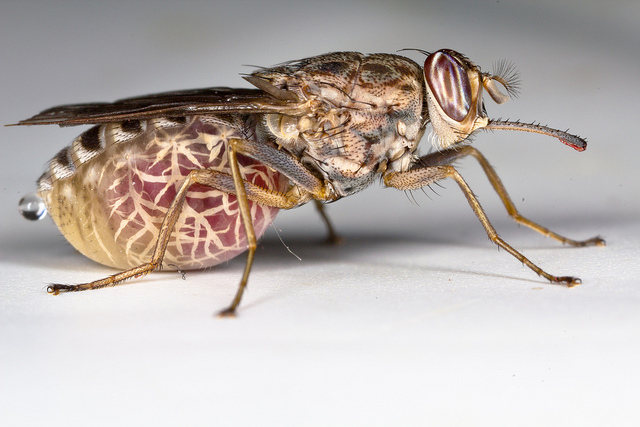Comparative dynamics of trypanosomiasis in tsetse fly populations
Overview
Tsetse flies emerge uninfected with the trypanosome that cause nagana in livestock and sleeping sickness in humans. As with mosquitoes, the flies must bite an infected vertebrate host in order to become infected themselves.
This group will analyse data collected in the field in Zimbabwe in which infection rates among samples of the tsetse flies G. m. morsitans and G. pallidipes were estimated for flies of different ages.
The flies can become infected with one or more of three species of trypanosomes, Trypanosoma vivax, T. congolense and T. brucei.
This group will model the acquisition of the three species by male and female flies and attempt to explain any differences they may find in the dynamics of the process.
Things to consider
- This group is recommended for participants who are interested in :
- Tsetse and trypanosomiasis
- Modelling the dynamics of infection of an insect vector
- Engaging, interpreting and analysing existing data
- Statistical analyses
- This group will have the opportunity to engage in any of the following:
- Calculating age-specific infection rates from raw data
- Understand and model how mammalian host density impacts tsetse survival probability and population growth rates
- Make dynamical models of the acquisition of trypanosome infections by tsetse flies
- Explaining the differences in the patterns of acquisition of different species of trypanosome infections by different species, and sexes, of tsetse
- Examining and explaining how the age-specific infection rates vary with season and climatic conditions
Background
- The data under consideration was carried out in Zimbabwe over an 8-year period in the 1990s.
- Tsetse flies were sampled using odour-baited traps. A female’s age was estimated from the number of times she had ovulated. Ages of both sexes could also be estimated from the degree to which the wings had become frayed.
Data
The following data sources and other resources will be made available to group members:
- Spreadsheet showing the number of each age group of male and female tsetse fly analysed and the number infected with one or other of the three trypanosomes
- Meteorological data from the research station
Resources
References
(available to project group, and upon request to other ICI3D participants)
- Harley, JMB (1966a). Seasonal and diurnal variation in physiological age and trypanosome infection rate of females of Glossina pallidipes Aus., G. palpalis fuscipes Newst. and G. brevipalpis Newst. Bulletin of Entomological Research, 56, 595-614. (download)
- Harley, J. M. B. (1966b). Studies on age and trypanosome infection rate in females of Glossina pallidipes Aust., G. palpalis fuscipes Newst. and G. brevipalpis Newst. in Uganda. Bulletin of Entomological Research, 57, 23-37. (download)
- Harley, J. M. B. (1967). Further studies on age and trypanosome infection rate of females of Glossina pallidipes Aust., G. palpalis fuscipes Newst. and G. brevipalpis Newst. in Uganda. Bulletin of Entomological Research, 57, 459-477. (download)
Tutorials
- Tutorial 4: Visualizing Infectious Disease Data in R (recommended)
